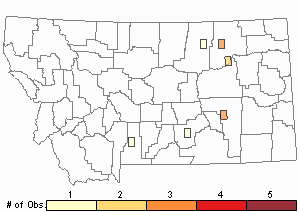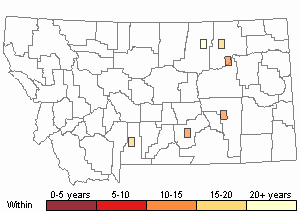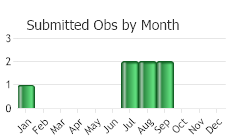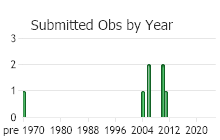View in other NatureServe Network Field Guides
NatureServe
Montana
Utah
Wyoming
Idaho
Wisconsin
British Columbia
South Carolina
Yukon
California
New York
Scarlet Ammannia - Ammannia robusta
Other Names:
Ammannia coccinea ssp. robusta
State Rank Reason (see State Rank above)
Known from a few extant populations and a historical collection in northeastern Montana. Likely occurs in additional wetlands in Montana east of the Continental Divide, though many of these would be on private lands and are unlikely to be surveyed for its presence.
- Details on Status Ranking and Review
Population Size
ScoreD - 1,000 - 2,500 individuals
Range Extent
ScoreF - 20,000-200,000 sq km (~8,000-80,000 sq mi)
Area of Occupancy
ScoreC - 3-5 4-km2 grid cells
Number of Populations
ScoreB - 6 - 20
Number of Occurrences or Percent Area with Good Viability / Ecological Integrity
ScoreA - No occurrences with excellent or good (A or B) viability or ecological integrity
Environmental Specificity
ScoreA - Very narrow. Specialist or community with key requirements scarce
Intrinsic Vulnerability
ScoreB - Moderately vulnerable
General Description
Plants: An annual with fibrous roots and hairless (glabrous) foliage. In Montana, stems are upright, 3-20 cm high, and can be simple or branched (Lesica et al. 2012; Hitchcock et al. 1961). Outside of Montana Ammannia robusta can grow much larger, up to 1 meter tall (Graham 1985).
Leaves: Leaves are in opposite pairs, with adjacent pairs at right angles to each other (decussate) (Graham 1985). Leaves are 1-4 cm long and narrow, with more or less parallel, entire margins (Lesica et al. 2012). Leaves tend to be fleshy (Graham 1985).
Inflorescence: A sessile cyme with lavender flowers in groups of 1-3 (sometimes 5) and located in the leaf axil (Graham 1985).
Phenology
Plants emerge when water levels drop during the summer (Douglas 1999). In British Columbia, germination occurs from late July to early September, and plants fruit from September to early October (Scarlet Ammannia Recovery Team 2008).
Diagnostic Characteristics
In the North American flora
Ammannia robusta has been overlooked because of its morphological similarity to
Ammannia coccinea (Graham 1985).
Ammannia robusta - Scarlet Ammannia, SOC
*Inflorescence: Cyme is sessile. Usually 1-3 flowers per leaf axil (cyme).
*Petals: Pale lavender, occasionally deeper purple veined.
*Anthers: Yellow.
*Fruits: Capsules are 4-6 mm in diameter and open irregularly.
Ammannia coccinea - Not Documented in Montana
*Leaves: Sessile and opposite.
*Inflorescence: Cyme with short to long peduncles, rarely completely sessile. Usually 3 or more flowers per leaf axil (cyme).
*Petals: Deep rose-purple.
*Anthers: Deep yellow.
*Fruits: Capsules are 3.5-5.0 mm in diameter and open irregularly.
Rotala ramosior - Toothcup, SOC
*Leaves: Non-clasping leaves with tapered bases, short petioles, and opposite.
*Flowers: White flowers and 1 per leaf axil.
*Fruits: Capsules break into four parts along weakened spots (septicidal dehiscence).
Some species of
Epilobium have opposite leaves, 4-parted flowers, and occur in wet sites; however, their petals and sepals are borne on top of the ovary rather than surrounding it, and the fruits are long and slender.
Species of
Gratiola,
Bacopa, and
Veronica all have opposite leaves, but their flowers are larger and have a united corolla.
Sources: Hitchcock et al. 1961; Graham 1985; Lesica et al. 2012; Culver and Lemly 2013.
Species Range
Montana Range
Range Descriptions

 Native
Native
Range Comments
Throughout much of central and western North America (Graham 1985). Where the ranges of Ammannia robusta and Ammannia coccinea overlap both species could be present at a single site (Graham 1985).
Observations in Montana Natural Heritage Program Database
Number of Observations: 11
(Click on the following maps and charts to see full sized version)
Map Help and Descriptions
Relative Density

Recency



 (Observations spanning multiple months or years are excluded from time charts)
(Observations spanning multiple months or years are excluded from time charts)
Habitat
Ammannia robusta occurs in the plains, in moist, often saline or alkaline soil, along wetland margins or in fields (Lesica et al. 2012). Habitats of herbarium specimens include mud near water, a sandy riverbank, and dry clay earth (CPNWH 2017). Populations have been found in in 0.5-meter deep water, but moist or saturated soil is the more typical microhabitat (Graham 1985).
Ecological Systems Associated with this Species
Ecology
Ammannia robusta grows on sites that experience periodic flooding cycles. It germinates in muddy soil after water levels drop. As an annual, population numbers can vary substantially from year to year, in part due to habitat conditions. Typically, it grows in dense stands, though in some years it can be scattered at low densities (Scarlet Ammannia Recovery Team 2008).
It is considered an obligate wetland plant by the US Army Corps of Engineers – almost always found in wetlands (Lichvar 2013). Ducks are known to eat Scarlet Ammannia fruits (Culver and Lemly 2013). In British Columbia, populations are associated with species that tolerate seasonal flooding, including Eleocharis parvula, Eleocharis acicularis, Rotala ramosior, and Gnaphalium sp. (Douglas 1999; Scarlet Ammannia Recovery Team 2008).
When growing in deeper water, the plants develop specialized tissues to transport air (aerenchyma), which is a common plant adaptation for wetland species (Graham 1985). Plants pre-dominately self-pollinate, beginning when the anthers and stigma are emerging from the flower cup (Graham 1985). The flowers are inconspicuous (Scarlet Ammannia Recovery Team 2008). A glandular area at the base of the ovary does produce nectar, which is used by skippers and small bees (Graham 1985). Scarlet Ammannia requires suitable water levels in order to thrive. It has some notable adaptations for its niche, including prolific production of seeds – each has an air sac, which allows it to disperse by floating (Graham 1985). Although seed viability drops to 50% after one year, some seeds may remain viable for a long time. The very closely-related Ammannia coccinea (not reported for Montana) showed 5% germination after 27 years in a herbarium (Graham 1985). A study in the midwestern United States found that A. coccinea persisted in the seed bank of at least two Iowa wetlands that had been drained for 37 years or more (Wienhold and van der Valk 1989). Under greenhouse conditions, seeds of Ammannia sp. germinated over a ten-week period, probably also an adaptive trait under variable wetland conditions (Graham 1985).
A germination study in Kentucky of two related summer annuals of similar habitats, Ammannia coccinea and Rotala ramosior, found that freshly-collected seeds gathered in the fall were dormant (Baskin et al. 2002). Seeds broke dormancy under flooded and unflooded conditions, but needed light exposure to germinate. Germination was generally better for seeds that had been flooded than those that had not.
An Iowa study of drained riverine wetlands found Ammannia robusta remaining in the seed bank of all 10 former wetlands sampled, which had been converted to agricultural crops (van der Valk 2013). Most species in the seed bank were associated with mudflats. Emergent and floating species were found in a few sites at very low densities, and submerged species were not present.
A study of a Texas river bottom examined the roots of Scarlet Ammannia and 37 other plants about three months after they had been inundated by record floodwaters (Stevens et al. 2009). Ammannia’s roots contained two different groups of symbiotic fungi, arbuscular mycorrhizae and dark septate endophytes, as did most other plant species on the site. Arbuscular mycorrhizae have beneficial relationships with most land plants and give increased resilience to floods and drought, among other benefits (Stevens et al. 2009). Dark septate endophytes tend to be more common in arctic and alpine ecosystems, and have been shown to increase the total biomass of plants under greenhouse conditions (Newsham 2011).
Reproductive Characteristics
Flowers: The sepals join to form a 2-3 mm long, globe-shaped cup (hypanthium) that is four-angled. The 4 separate petals have small blades that extend about 1 mm beyond the cup; the petals are short-lived (Hitchcock et al. 1961; Lesica et al. 2012). Their color is pale purple, sometimes with a deeper purple-red central spot or vein. The style and 4 stamens project slightly (Graham 1985).
Fruit: A nearly round capsule, 4-6 mm in diameter, which breaks open to release many seeds (Graham 1985; Hitchcock et al. 1961). In Canada, there are 15 to 45 fruits per plant, each with about 250-450 seeds (G.W. Douglas in Scarlet Ammania Recovery Team 2008).
Management
Ammania robusta is listed as Endangered in Canada, where about six populations remain. In British Columbia major threats include habitat loss due to shoreline development; changes in flood regime; and invasive species (Scarlet Ammannia Recovery Team 2008).
Stewardship Responsibility
Threats or Limiting Factors
STATE THREAT SCORE REASON
Reported threats to Montana’s populations of Scarlet Ammannia are those that manipulate the water regime in its habitat (MTNHP Threat Assessment 2021). Two populations were inundated at a site where water was captured to benefit a wetland mitigation effort. The potential for inundation or dewatering at other populations is an ongoing concern as outcomes following water management actions are difficult to predict.
References
- Literature Cited AboveLegend:
 View Online Publication
View Online Publication Baskin, C. C., J. M. Baskin, and E. W. Chester. 2002. Effects of Flooding and Temperature on Dormany Break in Seeds of the Summer Annual Mudflat Species Ammannia coccinea and Rotala ramosior (Lythraceae). Wetlands 22(4):661-668.
Baskin, C. C., J. M. Baskin, and E. W. Chester. 2002. Effects of Flooding and Temperature on Dormany Break in Seeds of the Summer Annual Mudflat Species Ammannia coccinea and Rotala ramosior (Lythraceae). Wetlands 22(4):661-668. Culver, D. and J. Lemly. 2013. Field Guide to Colorado's Wetland Plants: Identification, Ecology and Conservation. Fort Collins, CO: Colorado Natural Heritage Program. 694 p.
Culver, D. and J. Lemly. 2013. Field Guide to Colorado's Wetland Plants: Identification, Ecology and Conservation. Fort Collins, CO: Colorado Natural Heritage Program. 694 p. Dorn, R. D. 1984. Vascular Plants of Montana. Cheyenne, WY: Mountain West Publishing. 276 pp.
Dorn, R. D. 1984. Vascular Plants of Montana. Cheyenne, WY: Mountain West Publishing. 276 pp. Douglas, G. W. 1999. Status of Scarlet Ammannia in British Columbia. Victoria, B.C.: Ministry of Environment, Lands, and Parks, Wildlife Branch and Resources Inventory Branch. Wildlife Bulletin No. B-93.
Douglas, G. W. 1999. Status of Scarlet Ammannia in British Columbia. Victoria, B.C.: Ministry of Environment, Lands, and Parks, Wildlife Branch and Resources Inventory Branch. Wildlife Bulletin No. B-93. Douglas, G.W., D. Meidinger, and J. Pojar, editors. 1999. Illustrated Flora of British Columbia. Volume 3. Dicotyledons (Diapensiaceae through Onagraceae). British Columbia Ministry of Environment, Lands and Parks, and British Columbia Ministry of Forests, Victoria.
Douglas, G.W., D. Meidinger, and J. Pojar, editors. 1999. Illustrated Flora of British Columbia. Volume 3. Dicotyledons (Diapensiaceae through Onagraceae). British Columbia Ministry of Environment, Lands and Parks, and British Columbia Ministry of Forests, Victoria. Graham, S. 1985. A Revision of Ammannia (Lythraceae) in the Western Hemisphere. Journal of the Arnold Arboretum 66: 395-420.
Graham, S. 1985. A Revision of Ammannia (Lythraceae) in the Western Hemisphere. Journal of the Arnold Arboretum 66: 395-420. Lesica, P., M.T. Lavin, and P.F. Stickney. 2012. Manual of Montana Vascular Plants. Fort Worth, TX: BRIT Press. viii + 771 p.
Lesica, P., M.T. Lavin, and P.F. Stickney. 2012. Manual of Montana Vascular Plants. Fort Worth, TX: BRIT Press. viii + 771 p. Lichvar, R.W. 2013. The National Wetland Plant List: 2013 wetland ratings. Phytoneuron 2013-49: 1–241.
Lichvar, R.W. 2013. The National Wetland Plant List: 2013 wetland ratings. Phytoneuron 2013-49: 1–241. MTNHP Threat Assessment. 2021. State Threat Score Assignment and Assessment of Reported Threats from 2006 to 2021 for State-listed Vascular Plants. Botany Program, Montana Natural Heritage Program, Helena, Montana.
MTNHP Threat Assessment. 2021. State Threat Score Assignment and Assessment of Reported Threats from 2006 to 2021 for State-listed Vascular Plants. Botany Program, Montana Natural Heritage Program, Helena, Montana. Newsham, K. K. 2011. A meta-analysis of plant responses to dark septate root endophytes. New Phytologist, 190: 783–793.
Newsham, K. K. 2011. A meta-analysis of plant responses to dark septate root endophytes. New Phytologist, 190: 783–793. Scarlet Ammannia Recovery Team. 2008. Recovery strategy for the scarlet ammannia (Ammannia robusta) in British Columbia and Ontario. Peterborough, ON: Prepared for the British Columbia Ministry of Environment, Victoria, BC, and the Ontario Ministry of Natural Resources. 20 pp.
Scarlet Ammannia Recovery Team. 2008. Recovery strategy for the scarlet ammannia (Ammannia robusta) in British Columbia and Ontario. Peterborough, ON: Prepared for the British Columbia Ministry of Environment, Victoria, BC, and the Ontario Ministry of Natural Resources. 20 pp. Stevens, K. J., Wellner, M. R., and M. F. Acevedo. 2009. Dark septate endophyte and arbuscular mycorrhizal status of vegetation colonizing a bottomland hardwood forest after a 100 year flood. Aquatic Botany 92: 105-111.
Stevens, K. J., Wellner, M. R., and M. F. Acevedo. 2009. Dark septate endophyte and arbuscular mycorrhizal status of vegetation colonizing a bottomland hardwood forest after a 100 year flood. Aquatic Botany 92: 105-111. Van der Valk, A. G. 2013. Seed Banks of Drained Floodplain, Drained Palustrine, and Undrained Wetlands in Iowa, USA. Wetlands 33(1): 183-190
Van der Valk, A. G. 2013. Seed Banks of Drained Floodplain, Drained Palustrine, and Undrained Wetlands in Iowa, USA. Wetlands 33(1): 183-190 Wienhold, C.E., and A. G. Van Der Valk. 1989. The impact of duration of drainage on the seed banks of northern prairiewetlands. Can. J. Bot. 67: 1878-1884.
Wienhold, C.E., and A. G. Van Der Valk. 1989. The impact of duration of drainage on the seed banks of northern prairiewetlands. Can. J. Bot. 67: 1878-1884.
- Additional ReferencesLegend:
 View Online Publication
View Online Publication
Do you know of a citation we're missing? Consortium of Pacific Northwest Herbaria (CPNWH) Specimen Database. No Date. Plant specimen data displayed on the PNW Herbaria portal. Website http://www.pnwherbaria.org.
Consortium of Pacific Northwest Herbaria (CPNWH) Specimen Database. No Date. Plant specimen data displayed on the PNW Herbaria portal. Website http://www.pnwherbaria.org. Lesica, P., M.T. Lavin, and P.F. Stickney. 2022. Manual of Montana Vascular Plants, Second Edition. Fort Worth, TX: BRIT Press. viii + 779 p.
Lesica, P., M.T. Lavin, and P.F. Stickney. 2022. Manual of Montana Vascular Plants, Second Edition. Fort Worth, TX: BRIT Press. viii + 779 p.
- Web Search Engines for Articles on "Scarlet Ammannia"





